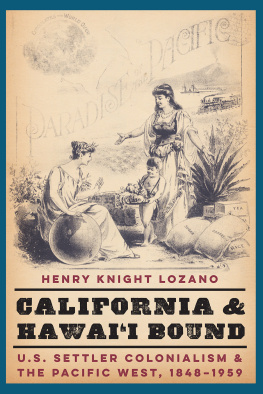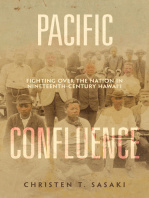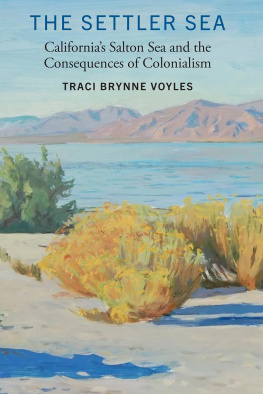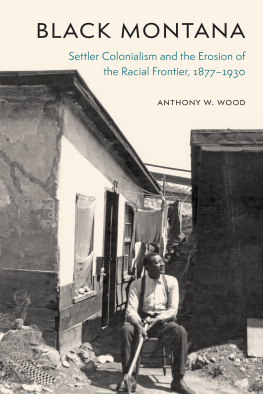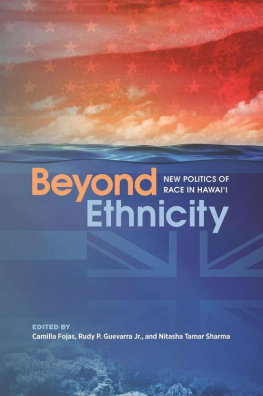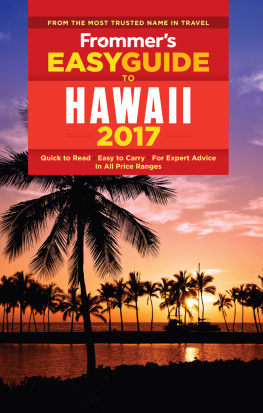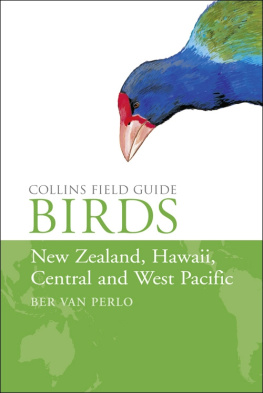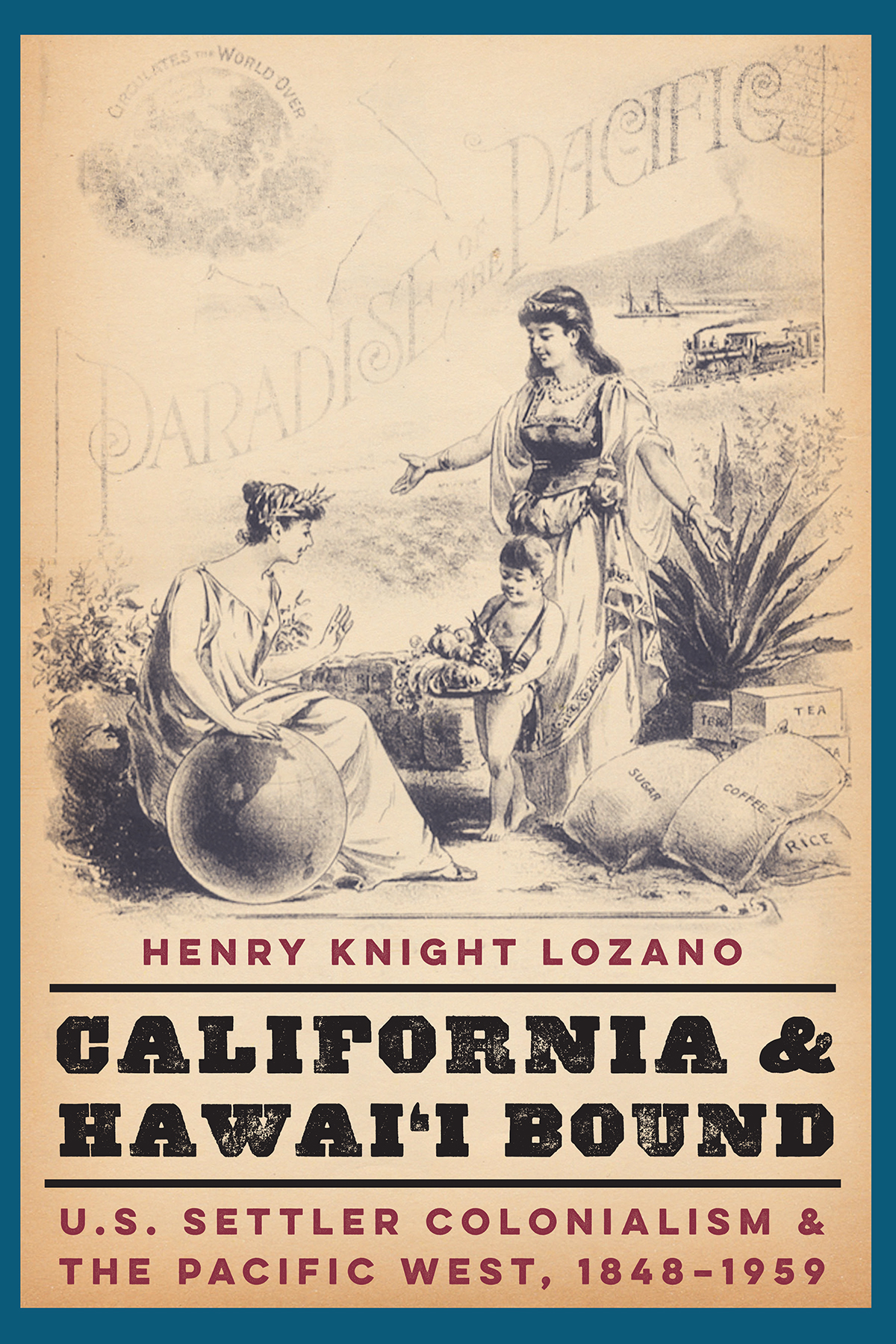
With subtlety and remarkable clarity, Knight Lozano employs settler-colonial theory to elucidate social and political developments in two distinct but intertwined Pacific societies. Time and again, we see that settler visions ran aground on historical realities, as Indigenous resistance and resilience shaped the new societies that emerged. But settler colonialism, extractive capitalism, and racial Manifest Destiny also proved resilient. A superb history of American empire in the Pacific West, California and Hawaii Bound is a must-read for scholars of the United States and global history in the modern era.
Seth Archer, assistant professor of history at Utah State University
Studies in Pacific Worlds
Series Editors
Rainer F. Buschmann
Katrina Gulliver
Editorial Board
Gregory Cushman
John Gascoigne
Andrea Geiger
Noriko Kawamura
Judith Schachter
California & Hawaii Bound
U.S. Settler Colonialism and the Pacific West, 18481959
Henry Knight Lozano
University of Nebraska Press | Lincoln
2021 by the Board of Regents of the University of Nebraska
Cover designed by University of Nebraska Press; cover image is from the interior.
Portions of chapter 3 were previously published in U.S. Settler Colonial Climates: Southern California, Hawaii, and the Healthful Tropics, American Nineteenth Century History 20, no. 2 (2019): 183204.
All rights reserved
Library of Congress Cataloging-in-Publication Data
Names: Knight, Henry, 1982 author.
Title: California and Hawaii bound: U.S. settler colonialism and the Pacific West, 18481959 / Henry Knight Lozano.
Other titles: U.S. settler colonialism and the Pacific West, 18481959
Description: Lincoln: University of Nebraska Press, [2021] | Series: Studies in Pacific worlds | Includes bibliographical references and index.
Identifiers: LCCN 2020045107
ISBN 9781496212139 (hardback)
ISBN 9781496227430 (epub)
ISBN 9781496227454 (pdf)
Subjects: LCSH : HawaiiHistory. | HawaiiRelationsCalifornia. | CaliforniaRelationsHawaii. | HawaiiCivilization. | CaliforniaCivilization. | National characteristics, Hawaiian. | United StatesTerritorial expansion. | Settler colonialismHawaii.
Classification: LCC DU 627 . K 65 2021 | DDC dc9.4/04 2397
LC record available at https://lccn.loc.gov/2020045107
The publisher does not have any control over and does not assume any responsibility for author or third-party websites or their content.
For April and Aria
Contents
Like an ocean crossing, this book has been a major undertaking, with some dicey moments along the way. I am indebted to numerous people and institutions that have supported me during its navigation. I was very fortunate to work alongside outstanding scholars in American history and American studies at Northumbria University. Many of them aided this project in different ways, more than they know, and provided guidance and friendship throughout my time in Newcastle-upon-Tyne: Brian Ward, Joe Street, Randall Stephens, Julie Taylor, David Gleeson, Ishan Ashutosh, Patrick Andelic, Sylvia Ellis, and Michael Cullinane, among others. My thanks also go out to Daniel Laqua, James McConnel, Charlotte Alston, Avram Grant, Connal Parr, Joe Hardwick, Laura OBrien, Colin Reid, Leona Skelton, Paul Frazer, and my colleagues in the Humanities Department for making it such an intellectually rich but also supportive and encouraging place to work.
Writing a history about the U.S. Pacific West from the northeast of England presents certain logistical obstacles. The research behind this work owes much to the Huntington Library and to the British Association of American Studies ( BAAS ) for generous fellowships and grants that got me out to the archives, as did financial support and research leave from Northumbria. Once there I benefited from the expertise of archivists at the research institutions, including specialists in the American West and the Pacific at the Huntington; librarians at the University of Southern Californias Special Collections and the Bancroft Library at Berkeley; and those at the Hamilton Library at the University of Hawaii, in particular Kapena Shim. Juan Gomez at the Huntington was incredibly supportive during my summer there. Historians I met on those tripsWilliam Deverell, Seth Archer, Natale Zappia, and Stacy Kamehiro, among othersalso shared invaluable insights.
My background is in American (U.S.) studies, and I came as a fascinated novice to the history of Hawaii. I do not read or speak Hawaiian. As a result, I am indebted to those scholars who do and whose archival work and scholarship have transformed our understanding of Hawaii, including its complex relationship with the United States; they include Noenoe Silva, David Chang, Noelani Arista, and others. Many scholars in the United Kingdom and the United States helped this project in different ways: Sue Currell, Clive Webb, Sarah Miller-Davenport, Tom Smith, Gary Okihiro, Natalie Zacek, James Hall, and Ian Scott. This list could go on. Both BAAS and the Association of British American Nineteenth Century Historians provided opportunities to share work in progress at their conferences, as did invitations to deliver seminars at Cambridge University, Newcastle University, Glasgow University, and others. Some of the material in chapter 3 previously appeared in an article in American Nineteenth Century History, the editors of which have kindly supported its republication here.
Throughout the writing and revising process, the University of Nebraska Pressespecially my editor, Bridget Barryhas been a constant source of insight and guidance. Always responsive to my queries, Bridget has been extremely helpful in developing the work, as were the presss anonymous readers, whose thoughts proved critical in improving the manuscript. I am excited and honored for the book to be part of UNP s Studies in Pacific Worlds series.
The professional debts are manythe personal ones more singular: my parents, Alan and Lidia, for always being curious about my work; for their (healthy) skepticism; and especially for looking out for me, not least these last few years, when at times Ive been at sea. Rachel, above all, for her kindness and patience but also for her wisdom and for challenging me in the best possible way; she knows, more than anyone, what this book has meant. It has been quite a journey together! Indeed, some of the archival research I first did for this book is older than our two young daughters, April and Aria, to whom it is dedicated. At three months old, April flew with us from London to Los Angeles to Honolulu. Aria would not arrive on the scene for another year and a half. They have, it is fair to say, slowed down its progress now and then, but they have also been vital to it. They have shaped these days and months and years (and the author) in myriad ways, large and small. In other words, I could not imagine this book without them. Thank you, my girls, for the laughter and the tears.
In August 1854 an American settler in the Kingdom of Hawaii, writing only as B.F.F., penned a letter to the Daily Alta California that served to link the islands conceptually and materially to California. A printer who had relocated from California to Honolulu, B.F.F. had invested in and taken inspiration from the arrival of a new ship from San Francisco, the Polynesian, which sparked discussion of a regular steamship line connecting the West Coast and the Hawaiian Islands. The oceanic space between them, he explained, will be annihilated. Crucially, a political union (or, depending on ones point of view, annihilation) appeared in lockstep with the transportation link. Talk of the imminent U.S annexation of Hawaii was rife in both locales: the sovereign ruler, King Kamehameha III, faced a crisis of external threat and internal division, as well as a native population devastated by disease, while the U.S. commissioner to the Kingdom of Hawaii, David Gregg, worked hard behind the scenes to secure a treaty to send to the U.S. Congress. On the West Coast rumors persisted of groups of California filibustersprivateers hell-bent on inciting a revolution and seizing powerbound for Oahu. In the bustling, gold-rich cities of San Francisco and Sacramento, American editors, investors, government officials, and lawmakers waited with bated breath for news of Hawaiis fate.
Next page
